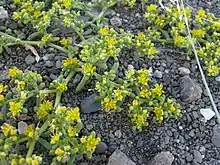| Tetraena simplex | |
|---|---|
 | |
| Scientific classification | |
| Kingdom: | Plantae |
| Clade: | Tracheophytes |
| Clade: | Angiosperms |
| Clade: | Eudicots |
| Clade: | Rosids |
| Order: | Zygophyllales |
| Family: | Zygophyllaceae |
| Genus: | Tetraena |
| Species: | T. simplex |
| Binomial name | |
| Tetraena simplex (L.) Beier & Thulin | |
| Synonyms[1] | |
Tetraena simplex, commonly known as hureim or simple-leaved bean caper, is a halophytic flowering plant that is distributed in arid regions of the Western Asia and Africa. It is an annual and has a history of being used in Arabic folk medicine as an anti-inflammatory.[2]
Description
Tetraena simplex is a highly branched succulent plant that stands from 8 to 20 cm tall. It has fleshy, simple leaves that are oblong-cylindric in shape. It flowers from August to May and presents with yellow petals.[3]
Distribution and habitat
Tetraena simplex is distributed throughout West Asia and Africa. It can be found as far east as India.[3] The most common habitats are shrub-steppes and deserts and it grows best in salty conditions.[4] In Qatar, it is known locally as daa or hureim (also spelled harm) and is a frequent sight on rocky desert plains.[5]
References
- ↑ "Tetraena simplex (L.) Beier & Thulin". Global Biodiversity Information Facility. Retrieved 14 June 2019.
- ↑ Hossam Abdallah; Ahmed M. Esmat (2017). "Antioxidant and anti-inflammatory activities of the major phenolics from Zygophyllum simplex L.". Journal of Ethnopharmacology. 205: 51–56. doi:10.1016/j.jep.2017.04.022. PMID 28465252. S2CID 4305115.
- 1 2 "Zygophyllum simplex". Flora of Pakistan. Retrieved 14 June 2019.
- ↑ "Tetraena simplex (L.) Beier & Thulin". Flora of Israel Online. Retrieved 14 June 2019.
- ↑ "Tetraena simplex (L.) Beier & Thulin". Flora of Qatar. Retrieved 14 June 2019.